#75mm gun
Explore tagged Tumblr posts
Text
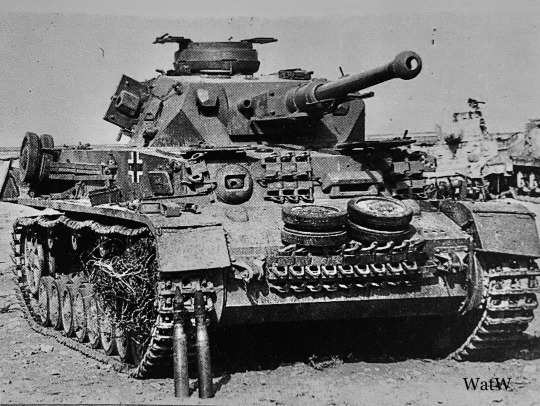
The German PzKpfw IV Ausf F2 was a comparatively simple evolution from the Ausf F with thicker armour and more importantly a long barrel 75mm gun for enhanced anti tank capabilities. This particular tank is somewhat unusual in having a single rather than double baffle muzzle break
#world war two#ww2#worldwar2photos#history#1940s#ww2 history#wwii#world war 2#wwii era#ww2history#panzer#panzer iv#PzKpfw#tank
175 notes
·
View notes
Note
What drinks could you see your I.M.P gang be?🍺🍸🍹🥂🍷
🔫Blitzø🐴: Moscow Mule. Strong, spicy but with sweet side(like him), and Iced(how he likes em and loves the name🫏. I imagine he can handle his liquor fairly well 🥃 and not really too picky with drinks. He def likes em hard enough to numb himself after a long day….or thinking too much on “stuff”.


🪓Millie🐂: Tequilla sunrise. Spicy & sweet, just how she likes em. Can really handle her liquor, even more than Blitz. Def enjoys spicy strong drinks like tequila! I can also see her have a bit of a sweet tooth so def enjoys a bit of sweetness with her drinks along with the spice, great balance! 🍹


🎼Moxxie🐊: French 75. Elegant & sweet just like him. I imagine Moxxie prefers lighter drinks, def a man of classic tastes 🍸🥂🍷 and fun fact, the drinks name was inspired from the 75mm field-gun used by the French during WW2🔫 perfect fit for our fav Gun-imp.


🌙Loona🐺: Blueberry Seltzer(fun fact wolves(I def see Loona be part wolf 🐺 ) actually like blueberries and in my take, Loonas a stoner and advice my friend @a-sterling-rose gave since I’m not the biggest expert with alcohol, weed & alcohol don’t mix very well so she’d most likely enjoy stuff like seltzers . I feel like if she had Beezlejuice it’d be watered down type of stuff or just flavour like it🍯🐝 I can def see her enjoy mocktails too like a Shirley Temple.


😈Addtional I.M.P facts😈
Blitzø would sometimes order Bloody Mary’s for his whole breakfast if he didn’t feel like making himself one🥓🥚 have you seen the kinda toppings they can get?! Calls it “brunching on a budget”.
Blitz loves doing drinking games 🥃🎱 would end up in the hospital trying to do “never have I ever”. Remeber when Quagmire was doing it? Like that🤣
Blitz is good at keeping track of happy hour 🍹🍻 other things not as much🤣
Blitz def enjoys getting crazy cocktails 🍹 enjoys trying out stuff with flashy colors and decor.
Alcohol tolerance High-low. Millie, Blitz, Moxxie & Loona.
DO NOT LET BLITZ &/OR MILLIE BE IN VEGAS! It will not end well
Millie’s great in drinking competitions would def do a shot competition with Blitz and win. Probably had tons of practice doing those with Sallie May(I can see her be a mint julep type). I imagine she def enjoys stuff with tequila too! I can see Striker be her best competition🥃
When it comes to Bar Trivia nights on the other hand…🩸not so well🩸 Warning, LOT of blood at the end.
Blitz & Mills have a fair share of bars they’re banned from. They sometimes keep track like a competition which Mox wish they didn’t.
Millie def went to a lot of saloon type bars back in Wrath. Loves the drinks. Loves the bar fights even more(there’s a very good chance she starts them or atleast def adding fuel to the fire) 💥🩸
Moxxie LOVES stuff like vineyard trips/wine tasting 🍷🍇 I don’t see Millie be too into wine/wine tours as much as Moxxie(I can totally see Blitz tag along if it means getting drunk with him). I can def see Moxxie being home meats & cheeses for Millie which she def enjoys 🍖🧀🫕
Moxxie def enjoys wine & cheese nights 🍷🥂🧀🫕 LOVES preparing charcuterie. Loona & Millie would most enjoy the meats, Blitz the cheese 🧀 🍖
Moxxies got a good collection of wine 🍷 great guy for asking to parties, brings good stuff.
Blitz has a lot of drink mixers.
I can see Moxxie be fairly good at making drinks himself🍸 even has his own lil kit. He was used to making em for his dad & associates.
Blitz has asked Mox for him tips & info about drinks/making them to make himself as well as occasionally impress Stolas🦉
If Loona was to drink stuff with alcohol I can see her like drinks such as Rum & coke, hard seltzer and champagne punch !
Loonas usually the designated driver for Blitz & the gang doing drink nights, second best chance would be Moxxie, third Millie🚐 Blitz is usually the one needing a designated driver with him.
What do u guys think? What drinks could u see fit the gang? I’d love to know💖
#helluva boss#helluva fanart#helluva boss redesign#helluva boss rewrite#helluva boss rewrittem#Blitzo#helluva millie#helluva blitzo#helluva blitz#blitz#moxxie#loona#helluva loona#hb headcanons#hazbin hotel redesign#my art#helluva redesign#helluva redesigns#helluva rewrite#HB asks#anon asks#hazbin hotel redesigns
40 notes
·
View notes
Text
Al Nakba War 1948

Four Arabs with automatic rifles guard an Arab village near Jerusalem.

Palestinian women and children driven from their homes by OccupationI sraeli forces, 1948.

Hafez Barakat (L), former leader of Futuwa movement, Abdel Kader al-Husseini, commander of Palestinian Arab forces in Jerusalem (c) and Kassem Rimawi (r), leader of Palestinian Arab Party 16 February 1948 during the offensive against Jews in Palestine.

Arab troops use mortars...These Lebanese soldiers of the Arab Army of Liberation are part of a heavy weapons group using French 75mm trench mortars. Such mortars have been used constantly during the past few weeks fighting for Jerusalem.

Palestinian husband and wife driven from their homes by Israeli forces, 1948

An officer inspects the Yarmuk Arab Liberation Army troops before throwing them into the fighting near Jerusalem.

Arab Boy Learning About Machine Gun

A picture released 10 January 1948 shows Arabs gathering with arms and leaving their village to march against a Jewish settlement in Palestine in response to the Haganah attack against "Arab el Sawarah" where people live in tents.

Arab Soldiers Controling The Road And Mountains During The The Nakba War, On The 10Th May 1948.

The Palestinian Resistance leader Abd al-Qadir al-Husseini with officers on the day he was killed.
#free plaestine#Palestine#Palestinian resistance#al nakba#war#1948#war history#فلسطين حرة#تاريخ فلسطين#tumblr#1940s#فلسطين#غزة تقاوم#photography#1948 palestine war#nakba 1948#فلسطین#تاريخ#تاريخي#wars history#guerrillas#تاریخ#arab#arabs#عرب#tumbler#تمبلر#غزة العزة#gaza#history
25 notes
·
View notes
Text
The MS-07B Gouf
In preparation for the invasion of Earth, Zeon forces modified a number of MS-06 Zaku-II F-types for use under the effects of the planet's gravity. The new "J-type" Zaku-IIs featured a number of internal hardware and software changes to enhance their viability on the ground.
The Zaku-II J-Type would be used as a testbed for new developments with the goal of creating a new mass-production mobile suit for use on the ground. And where the Zaku was intended for anti-ship and anti-aerospace combat, this new platform would be built to fight other mobile suits.
Zimmad and Zeonic would both begin working on this new project, directly competing with one another, but eventually coming up with very similar designs. Zeonic moved forward with the YMS-07A Prototype Gouf, and Zimmad presented the YMS-08A High Mobility Test Type.


While Zimmad's design failed to show a significant increase in performance from the Zaku-II J-Type, Zeonic's "Gouf" showed immense promise. The prototype would be picked up and would see a limited production run as the MS-07A Gouf.

The MS-07A was a pre-production model intended for data gathering. The final mass-production model would feature several additional weapon systems, such as an in-built 75mm machine gun in the left manipulator, and a retractable "Heat Rod" on the left forearm.


The Gouf was used to great effect by Zeon captain Ramba Ral, who went toe-to-toe with the Earth Federation's infamous RX-78-2 Gundam.

Among the Ace pilots who used the Gouf as their personal units, Viche Donahue, Silas Locke, and Norris Packard were among the most well-known. All three of these aces would become battlefield legends, with Packard's MS-07B-3 Gouf Custom becoming especially infamous. The machine's equipment proved so effective that it became a common alternate loadout for many Gouf pilots.



The MS-07 would be customized for a variety of roles and theaters, with many of these variants seeing further developments of their own.



Notable among these was the MS-07W Gouf Combined Test Type, which featured a miniaturized Dopp fighter serving as its cockpit. The development of the machine was heavily influenced by data gathered from the Federation's RX-series of mobile suits. Namely, their "Core Block" system.


The Gouf would also see another fork, being developed into the MS-07H Gouf Flight Type. While both prototypes made use of thermonuclear rocket engines, the final version used thermonuclear jet engines, allowing for greater efficiency in atmospheric flight.



The MS-07B saw further refinement into the MS-07C. While not much is known about its specifications, there are at least three known variants. A number of Goufs were acquired by Zimmad and used as testbeds for systems to be incorporated into the MS-09 Dom series of mobile suits. These Goufs were MS-07Cs.



And finally, in UC 120, nearly 50 years from the initial deployment of the original machine, Mars Zeon would develop and deploy the OMS-07RF RF Gouf. While externally resembling the MS-07B, the OMS-07-RF was a completely new machine which could also operate in space, unlike its predecessors.

The MS-07B Gouf was originally designed by Kunio Okawara for the 1979 Anime "Mobile Suit Gundam".
This article was a request! Requests are always welcome!
I am so terribly sorry for the delay in getting this post out! It's been a very hectic few months, but I'm hoping to get back in the flow of things!
20 notes
·
View notes
Text

An American soldier cleaning the 75mm gun on an M3 Lee tank in Tunisia in the winter of 1942-43.
33 notes
·
View notes
Text

'Acorn Inn', a self-propelled 75mm gun M3 half-track of the British 27th Lancers, North West of Mezzano Italy - February 18, 1945.
IWM - Dawson (Sergeant) Photographer.
83 notes
·
View notes
Text
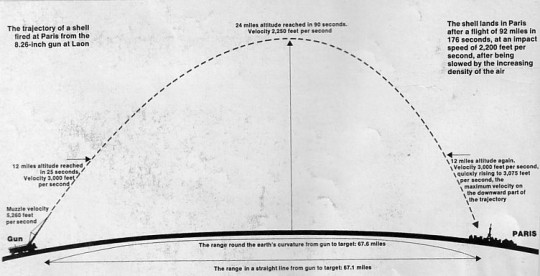

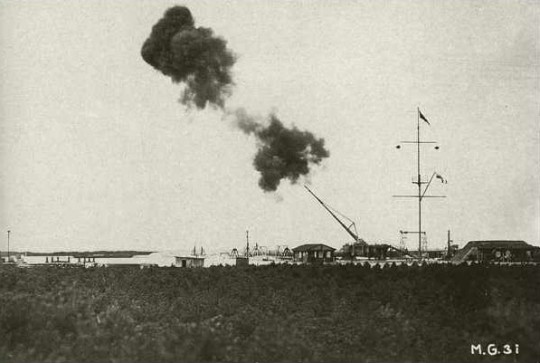
The Paris Gun
The Krupp arms-making dynasty was founded in Essen upon the fortune amassed by Arndt Krupp, who settled in that city in 1587. His son Anton expanded the family’s endeavors into making firearms during the Thirty Years’ War of 1618-1648, and the family progressively expanded its operations over the ensuing decades. In 1811, Friedrich Krupp (1787-1826) established a steel casting facility, and, although he successfully began casting steel in 1816, he expended considerable funds in the process. His son, Alfried (1812- 1887), continued his father’s work and eventually re-established the family fortune. By its nature steel was very difficult to cast, and internal faults were often impossible to detect through existing testing procedures. Defective cast steel pieces were also much more dangerous to crews than iron cannons, as the softer iron tended to split or burst with less energy than the harder steel, which more often ruptured with deadly violence. The Krupp firm’s success in casting steel was considered one of the major metallurgical achievements of its day.
Beginning in 1844, Alfried Krupp began experimenting in machining guns from solid cast steel blanks and in 1847 produced his first steel cannon. That same year he presented a steel gun to the King of Prussia, Frederick Wilhelm IV (1795-1861)-an act of entrepreneurial generosity that later won an order for 300 field guns. He went on to display a 6-pounder muzzleloading gun at the Great Exhibition of 1851 and began experiments in developing breechloading weapons. In 1856, Krupp introduced a 90mm field gun fitted with a transverse sliding breechblock that fit through a corresponding slot in the rear of the barrel.
Germany subsequently made the transition to rifled breechloaders during the 1860s, a move that gave it a distinct artillery advantage during the 1870-1871 Franco-Prussian War. Shortly after the war it adopted 78.5mm guns for its horse artillery and 88mm pieces for field use. The logistical difficulties associated with supplying two sizes of ammunition in the field and recent advances in metallurgy and gun design then led to the Model 73/88 system, which used the 88mm caliber for both horse artillery and field use and the later Model 73/91 system, utilizing nickel steel barrels. The Model 73/91 was finally superseded by Germany’s answer to the French 75-the Model 96 or Feldkanone 96 neur Art.
The development of specialized antiaircraft artillery also intensified during the war. The first documented use of antiaircraft artillery occurred as early as the siege of Paris during the Franco-Prussian War in 1870. At Paris, the Prussian commander von Moltke ordered weapons from Krupp in order to shoot down balloons in which the French were trying to sail over the Prussian lines. Krupp eventually delivered a number of single-shot, caliber 1-inch rifles that were mounted on pedestals bolted to the beds of two-horse wagons; they theoretically could follow the balloons on the ground while maintaining a steady firing rate. The Krupp pieces were relatively ineffective, yet at least one French balloon was apparently downed by their fire.
The rapid proliferation of powered military aircraft at the turn of the century, however, spurred an equally dedicated effort to neutralize the threat of air attacks. During the 1909 Frankfurt International Exhibition, Krupp unveiled three antiaircraft guns in a bid to monopolize the emerging market. These included a caliber 65mm 9-pounder and a 75mm 12-pounder. Krupp claimed that the largest, a pedestal-mounted 105mm gun intended for shipboard use, achieved a maximum ceiling of 37,730 feet. The caliber 65mm gun had an 18,700-foot range, could elevate 75 degrees, and its carriage had unique hinged axles that allowed the wheels to be pivoted to a position perpendicular to their traveling position. With the trail spade acting as its axis, this arrangement enabled the crew to traverse the piece 360 degrees to track enemy aircraft. With a claimed maximum ceiling of 21,326 feet, the caliber 75mm gun was mounted on a truck bed, thus giving it a high degree of mobility. Not to be outdone, Erhardt, Krupp’s closest domestic competitor, also exhibited a 50mm quick-firing antiaircraft gun mounted in an armored car’s turret.
The period also witnessed considerable experimentation in antiaircraft shells and fuses. Krupp introduced a high-explosive shell for its 3-pounder equipped with a “smoke-trail” fuse, an early tracer round that both aided the crews in sighting and was an effective incendiary against the hydrogen-filled airships of the period.
During World War I the Germans continued to experiment in antiaircraft weaponry, beginning in 1914 with the 77mm Ballonen-AK. The Ballonen-AK was then, in turn, followed in 1915 by the 77mm Luftkanone, a basic 77mm field cannon barrel mounted on a rotating scaffolding. The more effective Krupp 88mm FlaK entered service in 1918 and eventually became the inspiration for the famous World War II German “Eighty-Eight.”
Popularly named after Alfred Krupp’s daughter, the 41.3-ton, 420mm “Big Bertha” had a horizontal sliding block and fired a 1,719-pound shell up to 10,253 yards. Big Bertha required five tractors to transport its components, and it had to be assembled on site. In conjunction with a number of Austrian Skoda 305mm howitzers, the L/14 was first used with devastating effect against Liege in August 1914; it saw other action on both the Western and Eastern fronts. Owing to its relatively short range and vulnerability to Allied fire, Big Bertha was obsolete by 1917. Another heavy piece, the 211mm Mörser was adopted in 1916. It weighed 14,727 pounds and fired a 250-pound shell up to 12,139 yards.
Designed by Krupp engineers and adopted in 1918, the Paris Gun used the basic 380mm Max railroad gun barrel fitted with a barrel liner and lengthened 20 feet. The 210mm Paris Gun weighed 1,653,470 pounds and mounted a 2,550-inch barrel with a horizontal sliding block. It fired a 264-pound shell up to 82 miles. Crewed by naval personnel, the Paris Gun was so powerful that it fired its shells into the stratosphere, where the thinner atmosphere exerted less resistance, allowing such long ranges. The stress on the bore, however, wore the barrel significantly, and each succeeding projectile had to have progressively larger driving bands and heavier powder charges to compensate for the increasing windage. Although hugely inefficient in the final analysis, the Paris Gun’s greatest value lay in its use as a propaganda tool rather than an artillery piece. Source
27 notes
·
View notes
Text

MS-07B Gouf, a dedicated close quarters mobile suit for use on Earth. Larger, faster and better armoured in comparison to the Zaku but also much more expensive to produce. Despite its effectiveness, it only went through a short production run, as the more sophisticated MS-09B Dom was pushed into service.
As a close-quarters mobile suit, the Gouf has limited ranged weaponry in the form of 5 75mm guns built into the left hand. Otherwise it takes to the battlefield with a heat sword and shield, as well as a heat rod built into the right wrist. The heat rod is an extending cable capable of releasing electrical shocks to stun enemy mobile suits, or superheating to damage them.
147 notes
·
View notes
Text





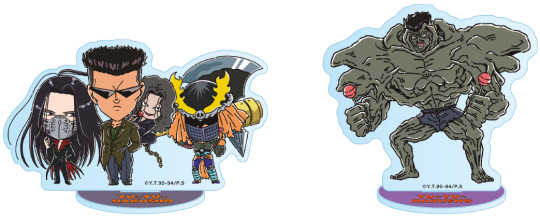
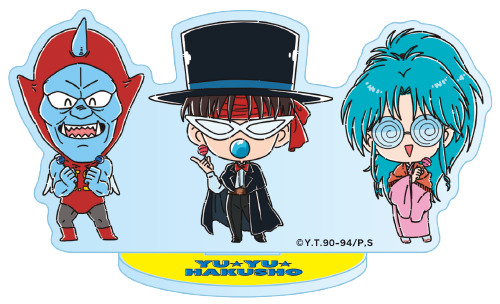



Yu Yu Hakusho x Oshi to Ame Special Collaboration at FavoteriA
The lollipop saga continues. Now, it's cute chibi chara!
This is the second collaboration of the candy brand "Oshi To Ame" (Ouchi de) and Yu Yu Hakusho. This time, it's a Yu Yu Hakusho Café that will take place at FavoteriA, in Ikebukuro. Drinks, Candies and Goods will be available. Some merch from the 1st collab are going to be sold at the cafeteria, and some merch from this event will also be sold on "Ouchi de" at a later date.
I'm impressed by the number of characters from this collab. Practically, the most important characters from all the seasons are here, even some members of the Reikai SDF. Eikichi on the top of Kuwabara's head is too cute.
🔶Official Site (menu): Favoteria
🔶Period: June 30 to July 12, 2023 (it's a short period)
🔶Venue: FavoteriA Ikebukuro
🔶Drinks & Novelty:

🔳DRINK MENU
Price: 750 yen
Yusuke Urameshi
Take this!!! Spirit Gun Drink!!!!!
Blue curacao; Sprite; Vanilla Ice-cream; Crackling candy
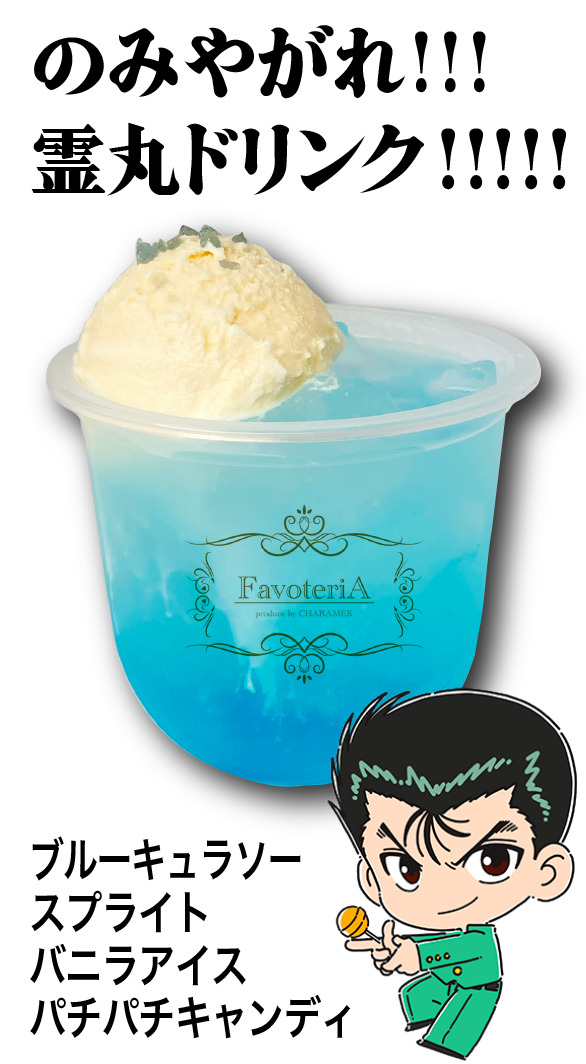
Kazuma Kuwabara
Come on, Spirit Sword!! Drink (Sour!)
Lemonade; Lemon; Chervil
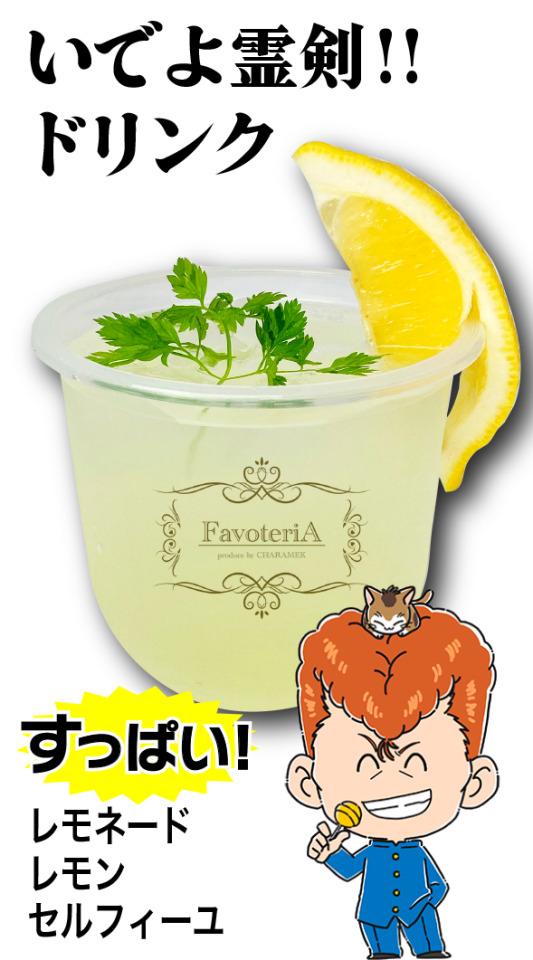
Kurama Drink
Rose Whip Drink
Milk; Strawberry Yogurt; Whipped Cream; Dried Raspberries; Rosemary
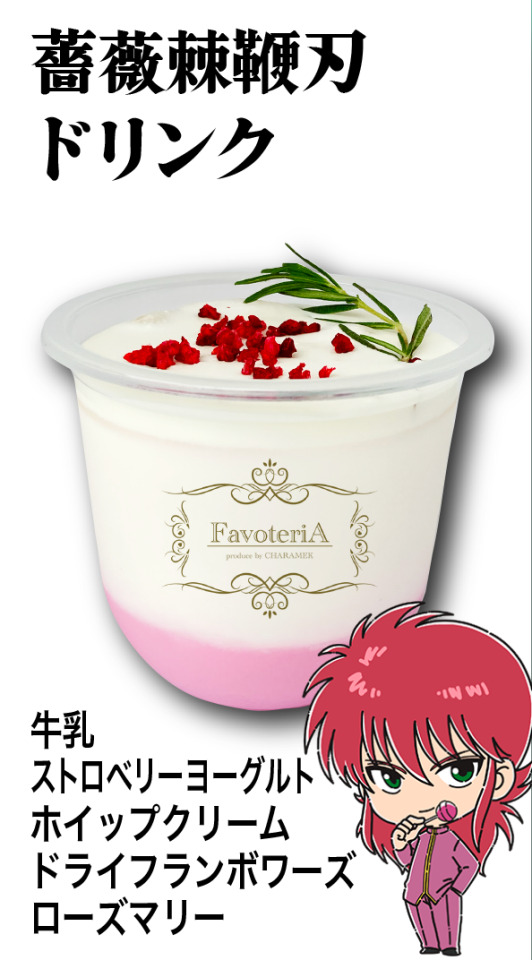
Hiei
Jaou Ensatsu Black Sesame Milk (Sesame Milk of the Darkness Flame)
Black sesame sauce; Black sesame milk; Whipped cream; Black cocoa powder

Youko Kurama Drink
Bad-tempered Demon World Ojigi Plant Drink
Matcha milk; Whipped cream; Cocoa powder; Matcha powder; Rosemary

For each drink ordered, one of the following novelties will be given at random:
🔳NOVELTY
You can choose from two types of novelties. Distribution will be random.
Bromide
5 types (random)
Size: 89mm×127mm

Mini Character Coasters
16 types (random)
Size: 90mm x 90mm

🔶Candy & Goods
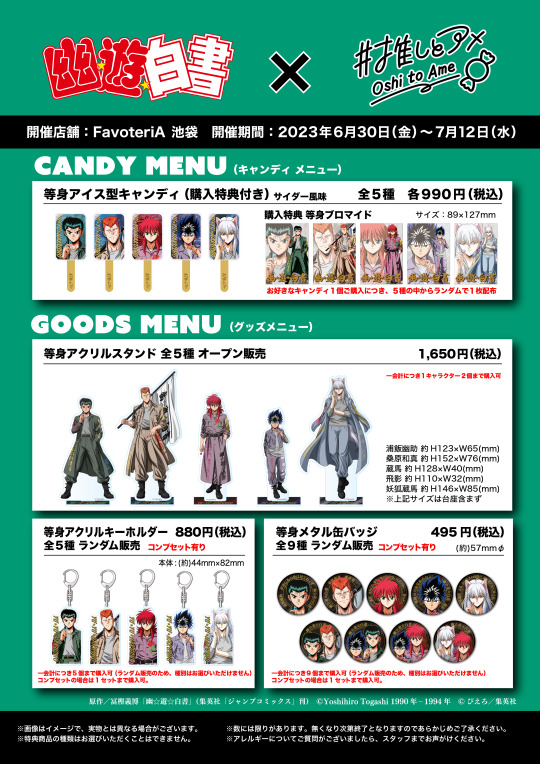

🔳CANDY MENU
Popsicle Cider Flavor (with purchase bonus)
5 types
Price: 990 yen each
Bonus: one random bromide (89×127mm) for each candy purchased.
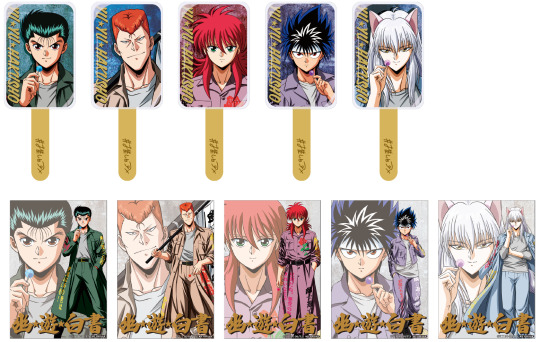
🔳GOODS MENU
The first three goods are the same from the first Ouchi De x Yu Yu Hakusho Collab.
Acrylic Stand (5 types): 1,650 yen each
Acrylic Keychain (5 types): 880 yen each (random)/Complete set available;
Metal Can Badge (9 types): 495 yen each (random)/Complete set available;

The others goods are from the new chibi chara art:
Mini Character Acrylic Stand Keychain
8 types (random); Complete Set available
Price: 880 yen each
Size:
Body: about 75mm x 103mm
Base: about 50mm x 30mm

Mini Character Acrylic Stand
8 types (random); Complete Set available
Price: 990 yen each
Size: about 75mm x 103mm; Pedestal: about 50mmx30mm

Mini Character Can Badge [A]
8 types (random); Complete Set available
Price: 440 yen each
Size: (approx.) 56mmΦ

Mini Character Can Badge [B]
8 types (random); Complete Set available
Price: 440 yen each
Size: (approx.) 56mmΦ

That's it, thanks for this amazing art ^^


#Yu Yu Hakusho x Oshi to Ame Special Collaboration#FavoteriA#Yusuke Urameshi#Kazuma Kuwabara#Kurama#Hiei#Youko KUrama#Raizen#Mukuro#Yomi#Suzaku#Byakko#Genbu#Seiryuu#Botan#Koenma#Jorge Saotome#Jin#Shishiwakamaru#Toya#Rinku#Beautiful Suzuki#Chuu#Toguro#Karasu#Toguro 100% of 100%#yanagisawa#yuu kaito#kido asato#Kamiya
142 notes
·
View notes
Note
I MADE MORE TANKS

Strisvogn m/39 Medium
76mm QF 17 pounder gun, fit easily because my dick is huge

Angrepskanonvogn m/39
Bofors 75mm Mountain gun
Assault gun varient of the Strv m/39 (above)

Panservernkanonvogn m/39
US 90mm M3 tank gun that somehow traveled back in time
TD Varient of Previous

Pansretbil m/39
I didn't actually design this one lol
I just stuck a 20mm Anti tank rifle in there lol

Strisvogn m/39 Britisk
Based on weird hybrid of Cromwell and Matilda, made by the developer, so no I didn't actually make this one either lol.
Same 90mm gun as the TD above.
(I also renamed the light tank to the Strisvogn m/38, which is definitely not confusing in the slightest)
All the names are weird janky mashings of Norwegian, cause I'm kinda shit at Norwegian.
I don’t think I’ve ever asked, what game is this lmao
11 notes
·
View notes
Text

A hull down M4A4 FL-10 in service with the Egyptian National Army's 20th Palestinian Division in the Gaza Strip, 1967.
This tank is an M4A4 "Sherman" outfitted with a French FL-10 turret as used on the AMX-13. It featured a 12-round autoloader and high velocity 75mm gun. This conversion was done for Egypt in the 1950s, with their last use being during the Six Day War. After the war, they were largely replaced with Soviet tanks, such as the T-54, T-55, and T-62.
37 notes
·
View notes
Text
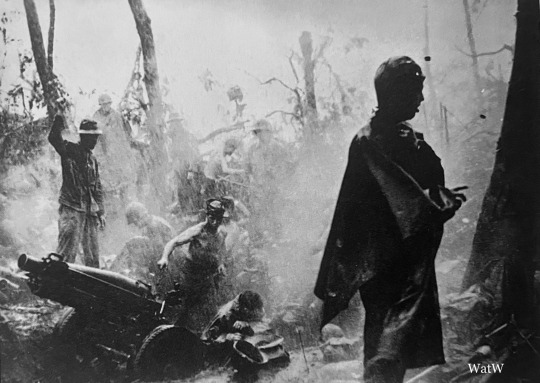
A tropical downpour drenches the Australian crew of a 75mm gun as it fires on Japanese positions on New Britain in the Bismarck Archipelago - Dec 1943
#world war two#1940s#worldwar2photos#history#ww2#wwii#ww2 history#wwii era#world war 2#ww2history#australian army#Anzac#1943#pacific#war in the pacific#new britain#bismarck archipelago
122 notes
·
View notes
Text
Okay, so, I found something



yeah, so, uh, for those with an interest in military technology or naval warfare, this will require a second glance. But the Swedish wording of this is "PROPOSAL FOR AIR CRAFT CARRIER CRUISER WITH 6 210MM GUNS"
So, uh, this seems to have been the pet project of one Harry Åbom who drafted this sketch in 1946 and it is not mentioned anywhere else in the Swedish navy command correspondence, except for this sketch in the war archives - seemingly it was a proposal that just never went anywhere because there was no benefit for the Swedish navy when it never went too far away from air field coverage, and if they ever wanted any carriers they could just buy them as surplus from the US or Great Britain.
Below I will present the translation (and added info for context)... and oh boy, strap yourselves in.
Guns 6: - 210 mm gun 3 barrel turret 8: - 120mm - - 2 barrel turret 30: 40mm - - two and one barrel tripod/gun pod Hull armour Above water belt: 70 and 70 mm (rear 40mm) Torpedo belt: 80 mm Flight deck and other hangar: 25mm Hangar deck: 25mm Torpedo deck: 75mm Sides and ends: 50mm PROPOSAL FOR AIR CRAFT CARRIER CRUISER With 6 210mm guns Keel length: 160m Keel width: 22m Underwater compartment: 6.1m Displacement: 12,000 tons Displacement standard: 11,500 tons Speed with 40,000 horsepower: 26 knots Air craft: 16.
#navy#marine#military#hitory#sweden#swedish navy#cruiser#air craft carrier#carrier#sketch#concept art
7 notes
·
View notes
Text

Aisne Area, France. 1918-06-22. A French Army artillery crew near Monchy Humieres in action with a 75mm gun. The men are wearing a newly developed gas mask. (Donor French Government)
10 notes
·
View notes
Text

The Ares XM274 75mm rapid fire hyper-velocity gun mounted on a LAV in a experimental fire-support role.
26 notes
·
View notes
Text

Hi, before I explain my post, I want to say something important.
• What you see my blog has become a major overhaul. And despite the changes, I decided that my 2nd account will be now my artwork blog with a secret twist.
⚠️NEW RULE! (W/ BIGGER TEXT!)⚠️
⚠️ SO PLEASE DO NOT SHARE MY 2nd ACCOUNT TO EVERYONE! THIS SECRECY BLOG OF MINE IS FOR CLOSES FRIENDS ONLY!⚠️
• AND FOR MY CLOSES FRIENDS, DON’T REBLOG IT. INSTEAD, JUST COPY MY LINK AND PASTE IT ON YOUR TUMBLR POST! JUST BE SURE THE IMAGE WILL BE REMOVED AND THE ONLY LEFT WAS THE TEXT.
⚠️ SHARING LINKS, LIKE POSTS, REBLOG POSTS, STEALING MY SNAPSHOT PHOTOS/RECORDED VIDEOS/ARTWORKS (a.k.a. ART THIEVES) OR PLAGIARIZING FROM UNKNOWN TUMBLR STRANGERS WILL IMMEDIATELY BE BLOCKED, RIGHT AWAY!⚠️
😡 WHATEVER YOU DO, DO NOT EVER LIKED & REBLOG MY SECRET POST! THIS IS FOR MY SECRET FRIENDS ONLY, NOT YOU! 😡

Okay? Capiche? Make sense? Good, now back to the post…↓
#OnThisDay: Aug 20th, 2013
Title: Perfect Strike Spot
Here it is, the moment you've been waiting for! The combination of all three main armored "Strike's" (Model: GAT-X105) Striker Packs (Aile ✈️, Sword 🗡️, and Launcher 🔫) into one heavy armor of weaponry machine, with a few adjustments/upgrades! 🤖😁 Not to mention, it serves as an inspiration to the lighted and improved version of this armor called the "Destiny" (Model: ZGMF-X42S)! This here is the armor "Perfect Strike"! ✈️🗡️🔫🤖😁
Perfect Strike Spot Based on: GAT-X105+AQM/E-YM1 Perfect Strike Gundam [CLICK ME!]
Armament(s):
• "Igelstellung" 75mm multi-barrel Anti-Air CIWS (optional armor piece) Mounted in the Perfect Strike's head are two "Igelstellung" 75mm multi-barrel CIWS guns. These light projectile weapons are mainly used for warning shots, intercepting missiles and to destroy lightly armored targets.
• "Armor Schneider" Combat Knife Stored in the Perfect Strike's side skirt armor are a pair of folding "Armor Schneider" combat knives. These knives do not need power from the suit, can be thrown, and their blades vibrate at high frequencies to pierce through most armor except PS armor.
• Beam Saber Stored in the modified Aile Striker is a pair of beam sabers. These are close range combat weapons that can slice through any armor that does not have an anti-beam coating.
🟦 For Sword 🗡️🤖 and Launcher 🔫🤖 Striker Packs' information, please click the link from the "Previous" section, down below. ↓ 🟩
Special Equipment/Feature(s):
• Battery Pack As the Multiple Assault Striker integrates the primary functions of the Aile, Sword and Launcher Striker Pack, it ended up with high energy consumption. To compensate for this, four additional battery packs are attached to its back. Each battery can be jettisoned after its energy is used up to avoid being dead weight.
• Phase Shift Armor The Launcher & Sword Striker Packs are equipped with phase shift armor. When activated the Launcher Strike's color is changed from a light grey to a white scheme with a bit of blue and red mixed in. Phase Shift armor, when activated, renders the Strike immune to physical attacks such as bullets, physical blade combats, or against missiles. However Phase Shift armor continually drains the battery of energy, shortening the mobile suit's combat endurance, and uses up additional energy when it is hit.
Previous: • 🟩 Launcher and Sword 🟦 (Aug 25th, 2013) • Spot's Descending Sword (Mar 25th, 2013)
Spot Speedster (Chowder OC) - created by ME! Armor (Mobile Suit Gundam SEED) - Gundam series © Bandai Namco Filmworks, Inc. (SUNRISE), Sotsu
2 notes
·
View notes